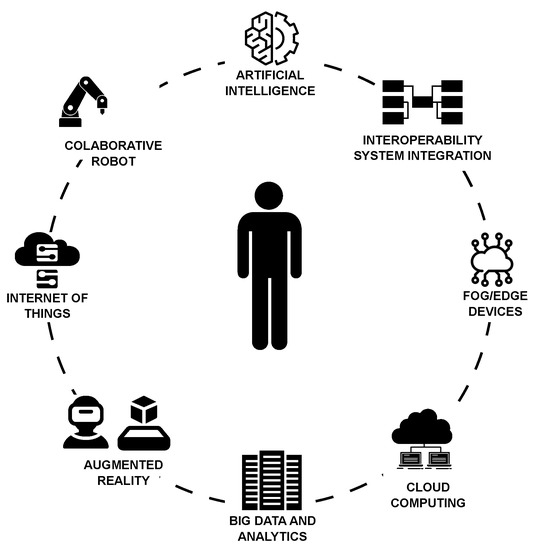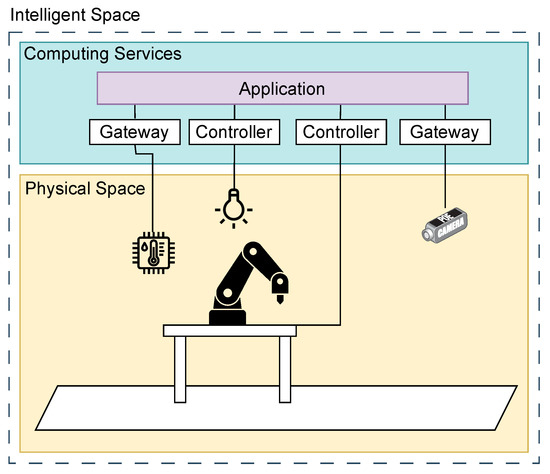Industry 5.0 (I5.0) represents a shift towards a human-centered industry and emphasizes the integration of human and machine capabilities. A highly compatible concept for enabling the I5.0 implementation is intelligent spaces (ISs), i.e., physical spaces equipped with a network of sensors, which obtains information about the place it observes, and a network of actuators, which enables changes in the environment through computing services. These spaces can sense, interpret, recognize user behavior, adapt to preferences, and provide natural interactions between humans and intelligent systems, using the IoT, AI, computer vision, data analytics, etc., to create dynamic and adaptive environments in real time.
1. Introduction
The rapid advancement of Industry 4.0 (I4.0) technologies has brought many changes and benefits to the manufacturing sector [
1]. However, these technological advancements also brought some negative impacts on human beings. A point of concern that can be mentioned is the potential displacement of human workers due to automation and the adoption of artificial intelligence (AI)-based systems [
2]. This displacement leads to job losses and economic inequalities, as individuals may struggle to adapt to the changing skill requirements in the labor market [
3,
4]. Thus, the industry and the academia started the transition from I4.0 to Industry 5.0 (I5.0), which goes beyond technological advancements and brings a new paradigm shift in manufacturing processes, with the goal of creating a human-centered industry by integrating human workers and advanced robotic systems to enhance productivity and collaboration, creating a new era of intelligent, interconnected systems [
5,
6,
7,
8,
9].
Alongside the I4.0 technologies such as the Internet of things (IoT) [
10] and its variants (the green IoT [
11,
12] and industrial IoT [
13,
14]), big data analytics, [
15] and machine learning algorithms [
16], this transition, illustrated in
Figure 1, is enabled by the implementation of I5.0’s main building blocks: individualized human–machine interaction technologies that interconnect and combine the strengths of humans and machines; bioinspired technologies and smart materials that allow for materials with embedded sensors and enhanced features while being recyclable; real-time-based digital twins and simulation to model entire systems; data transmission, storage, and analysis technologies that are able to handle data and system interoperability; AI to detect, for example, failures in complex and dynamic systems, leading to actionable intelligence; and technologies for energy efficiency, renewables, storage and autonomy [
17]. This results in an interconnected manufacturing ecosystem that enables the industry to respond to this paradigm shift.
Figure 1. I5.0 ecosystem with human–centered technologies.
I5.0 presents a human-centric transformative concept and brings a holistic development perspective that aims to foster a flourishing manufacturing system, embracing the integration of advanced technologies, collaborative human–machine interaction, and a focus on long-term viability and social well-being [
18]. In I5.0, humans are not replaced by machines; instead, they work alongside robots and intelligent systems to leverage their respective strengths [
19]. This collaboration allows more complex and creative tasks, with humans providing critical thinking, problem-solving, and adaptability, while machines contribute with precision, speed, and repetitive task execution [
20].
Moreover, a highly compatible concept for enabling the I5.0 implementation is the intelligent space (IS). An IS, represented in
Figure 2, can be defined as a physical space equipped with a network of sensors which obtains information about the place it observes, a network of actuators which allows its interaction with users, and changes in the environment through computing services. Such sensors, actuators, and computing services must be governed by an infrastructure capable of collecting and analyzing the information obtained by the sensors and making decisions [
21,
22,
23]. One of the key concepts within ISs is that the environment can sense, interpret, recognize user behavior, adapt to preferences, and provide natural interactions between humans and intelligent systems, using the IoT, AI, computer vision, and data analytics to create dynamic and adaptive environments in real time.
Figure 2. IS composed by a network of sensors and a network of actuators.
The integration of ISs and I5.0 has paved the way for the development of cognitive factories, marking a significant milestone in the evolution of manufacturing. The cognitive factory idea is not new and can be defined as a physical industrial environment transformed into an IS that can perceive, learn, and interact with humans and machines in a seamless and adaptive manner [
24,
25,
26]. These factories can leverage the technologies already mentioned and illustrated in
Figure 1 to enable real-time data collection and analysis, allowing predictive maintenance and process optimization continuously. In addition, by integrating cyberphysical systems (CPS), i.e., the convergence of operational technology (OT) and information technology (IT), they blur the boundaries between physical and digital systems, enhancing the communication and coordination between machines, humans, and products, resulting in a more agile and responsive manufacturing ecosystem [
27].
Since a cognitive factory can be composed of smaller aggregated units containing sensors, devices, systems, and subsystems, integrated or not, in this article, these smaller aggregated units are denominated cognitive cells, and the definition is stated as a fundamental component that operates as an intelligent unit equipped with cognitive technologies to enhance manufacturing processes. These cells represent a significant departure from traditional automation and digitalization approaches. While automation and digitalization focus on enhancing efficiency and productivity through the use of advanced technologies, the cognitive cell goes beyond that by incorporating cognitive capabilities and human–machine collaboration. Unlike traditional systems, the cognitive cell leverages AI, edge/fog computing, and advanced sensing capabilities to enable an adaptive behavior. By integrating human intelligence and problem-solving skills with machine precision and speed, the cognitive cell creates a dynamic and interactive environment where humans and machines work together.
2. Industry 5.0
The transition from I4.0 to I5.0 has garnered significant attention in recent years as technological advancements continue to reshape the industrial landscape and represent a significant paradigm shift in the global industrial landscape. Extensive research has been conducted to explore the aspects and implications of this technological progression. Scholars such as [
28,
29] have examined the potential benefits of I5.0, emphasizing its ability to foster greater human–machine collaboration and enhance productivity. Additionally, the study developed by [
30] has delved into the challenges and barriers associated with this transition, including the need for upskilling the workforce and ensuring the ethical use of emerging technologies.
Moreover, researchers have investigated the key technological components that underpin the transition from I4.0 to I5.0. For instance, [
31] conducted an in-depth survey on enabling technologies and their findings highlight the potential use of edge computing, digital twins, cobots, the Internet of Everything (IoE), big data analytics, blockchain, and future 6G systems. In a similar vein, [
32] explored the significance of big data with AI in I5.0. The study revealed how AI can augment decision-making processes, optimize production workflows, and enable adaptive and autonomous systems.
Scholars also consider that the transition to I5.0 is already underway. For example, the study by [
33] proposed a cyberphysical human-centered system (CPHS) that utilized a hybrid edge computing architecture with smart mist-computing nodes to process thermal images and prevent industrial safety issues. In the work, the authors demonstrated in a real-world scenario that the developed CPHS algorithms could accurately detect human presence with low-power devices in a fast and efficient manner, complying with the I5.0 paradigm.
In the context of I5.0, the integration and coordination of interconnected systems play a vital role in achieving a consistent data flow and efficient resource utilization. Extensive research has been conducted to investigate the interconnection of edge devices and cloud infrastructure to create a distributed computing ecosystem. Scholars have proposed some architectural frameworks and protocols for enabling the integration and collaboration of these systems [
33,
34,
35].
Edge computing has emerged as a promising paradigm to address the requirements since the arrival of I4.0. Researchers have recognized the significance of these computing models in enabling efficient data processing and analytics at the network edge. Studies have shown that edge computing facilitates real-time data processing and reduces network latency by moving computation closer to data sources [
36,
37,
38]. Although not focused on I5.0 but rather on I4.0, [
39] proposed an edge-computing-based industrial gateway for interfacing IT and OT that could enable I4.0’s vertical and horizontal integration.
Similarly, fog computing extends the capabilities of edge computing by providing a decentralized computing infrastructure that bridges the gap between edge devices and the cloud, enabling data processing, storage, and analysis closer to the network edge [
40,
41].
Besides those mentioned technologies, [
42] proposed a communication architecture based on a message bus to enable not only communication to cross conventional physical borders but also to provide scalability to growing data volume and network sizes. The author argued that such architecture had the potential to renew industrial communications. At last, [
43] presented a new middleware broker communication architecture for protocols used by the IoT.
In conclusion, the literature review on the communication architecture for cognitive factories reveals an important role in supporting the integration and operation of cognitive technologies in manufacturing environments. The studies demonstrated the importance of designing efficient frameworks that enable real-time data exchange, support collaboration, and ensure the interoperability within cognitive factory systems. By addressing the challenges and considerations associated with the communication architecture, researchers can advance the development and implementation of cognitive factories, paving the way for future advancements in intelligent manufacturing systems.
This entry is adapted from the peer-reviewed paper 10.3390/smartcities6040088


